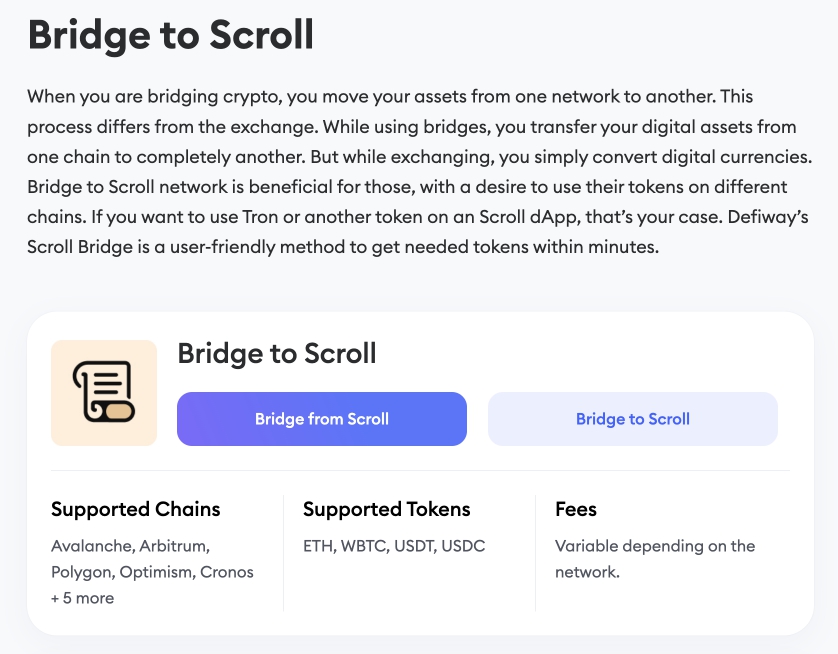Scroll is a layer-2 scaling solution for Ethereum that aims to improve the scalability and efficiency of the Ethereum network. It uses zk-rollups, a technology that allows for the efficient processing of large numbers of transactions off-chain, which are then bundled and posted to the Ethereum mainnet. This allows for faster and cheaper transactions on Scroll, while still maintaining the security and decentralization of Ethereum.
Here are some of the advantages of Scroll:
- Scalability: Scroll can process a large number of transactions per second, which is much faster than the Ethereum mainnet.
- Low fees: Transactions on Scroll are much cheaper than on the Ethereum mainnet.
- Security: Scroll inherits the security of the Ethereum network, which is one of the most secure blockchains in the world.
- Decentralization: Scroll is a decentralized network, which means that it is not controlled by any single entity.
Here are some of the top cross-chain bridges on Scroll:
Defiway
Defiway is a decentralized finance (DeFi) platform that has its own bridge, wallet, payroll, and other products. A cross-chain bridge allows users to transfer assets between different blockchains, including Scroll. Defiway supports 10+ blockchains.
Defiway supports not only various EVM networks, but also Tron and Solana. Defiway’s smart contracts are audited by Certik. Users can bridge tokens from/to Scroll to/from BNB, ETH, POL, ARB, BASE, OP, SOL, TRON, LINEA and other blockchains.
Stargate
Stargate is a cross-chain liquidity network that allows users to transfer assets between different blockchains, including Scroll. It is one of the most popular cross-chain bridges on Scroll, with over $1 billion in total value locked (TVL). Stargate supports 30+ blockchains. One of the features is choosing transfer type: Fast to move assets quickly or Economy to move assets cheaply.
Orbiter
Orbiter is a cross-chain bridge that allows users to transfer assets between different blockchains, including Scroll. It is known for its fast and secure transactions. Orbiter supports 10+ blockchains. It has a Points System which allows users to earn prizes for bridging.
Synapse
Synapse is a cross-chain bridge that allows users to transfer assets between different blockchains, including Scroll. It is one of the most popular cross-chain bridges on Scroll, with over $1 billion in total value locked (TVL). Synapse supports 20+ blockchains and also has Staking, Pools, and Explorer.
Router Nitro
Router Nitro is a cross-chain bridge that allows users to transfer assets between different blockchains, including Scroll. It is known for its low fees and fast transactions. Router Nitro supports 15+ blockchains.
Symbiosis
A decentralized bridge offering a user-friendly interface and competitive fees. Symbiosis supports 25+ blockchains.
Celer
Celer is a cross-chain bridge that allows users to transfer assets between different blockchains. It is known for its high throughput and low latency. Celer supports 15+ blockchains.
Conclusion
These are just a few of the many cross-chain bridges that are available on Scroll. As the Scroll ecosystem continues to grow, we expect to see even more cross-chain bridges emerge, making it easier for users to transfer assets between different blockchains.
Among the bridges mentioned, Defiway stands out. This bridge offers excellent liquidity, allowing you to swap any amount without issues. Its speed and fees are also top-notch. Moreover, Defiway's support for the Solana and Tron networks sets it apart from other options.
























